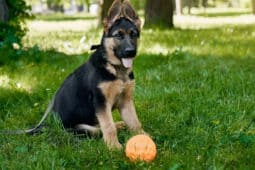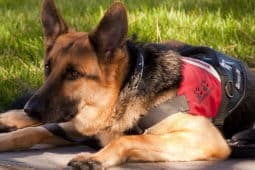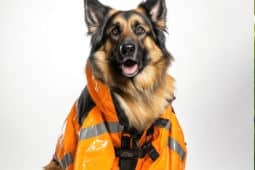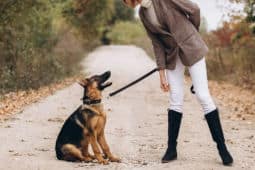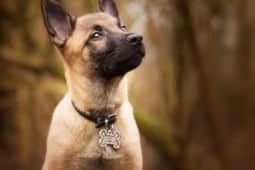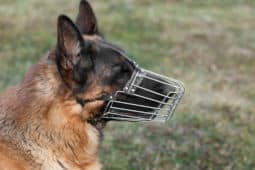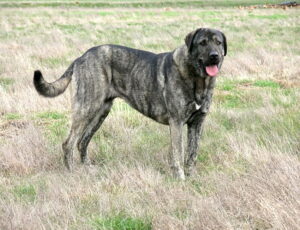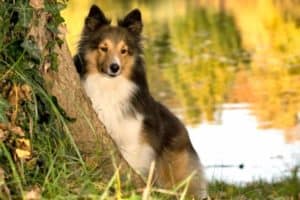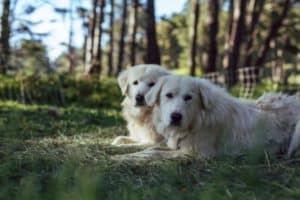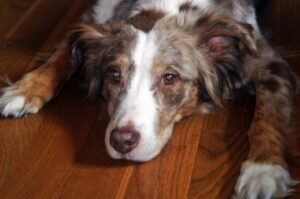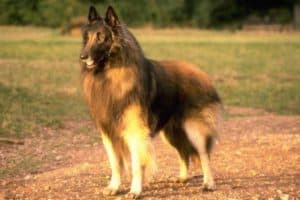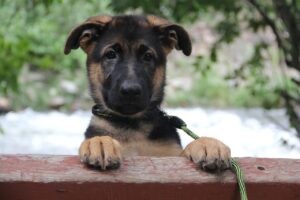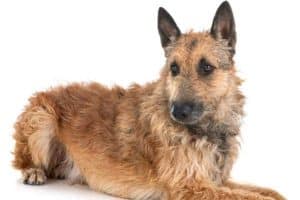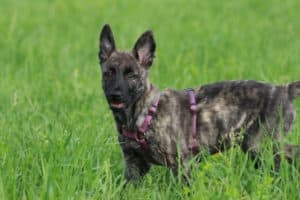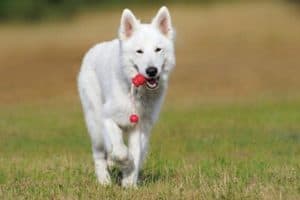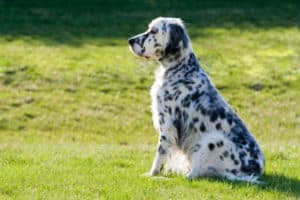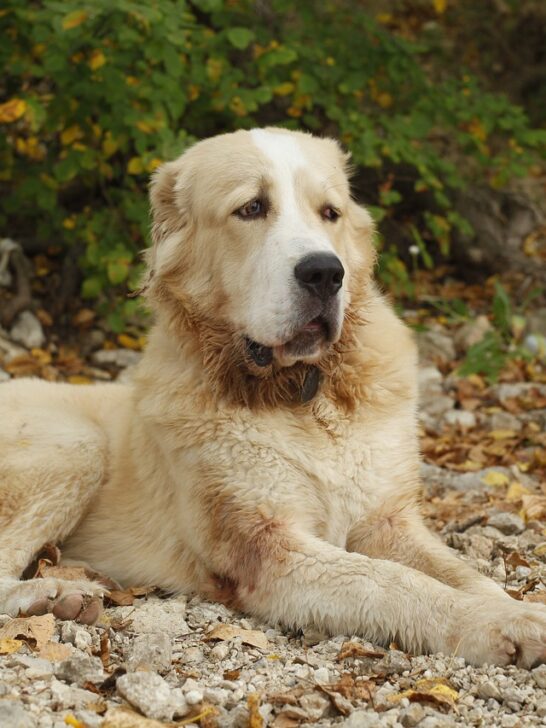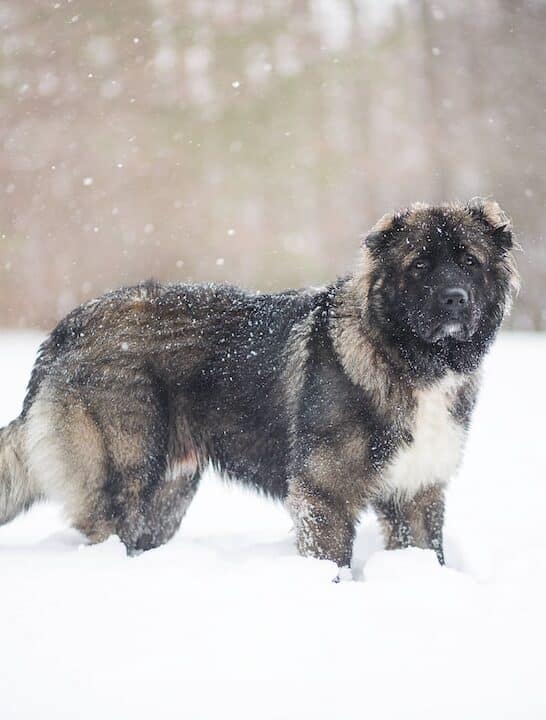German Shepherd Breed Types and Should We Want the Best in Show?
Have you noticed there is more than one distinct type of German Shepherd?
Some dogs have an obvious German Shepherd appearance but at the same time look quite different than how you are used to seeing the breed.
The variations go beyond a long-haired versus a short-haired dog.
In this article, we’ll talk about German Shepherd breed types, including working lines and show line dogs.
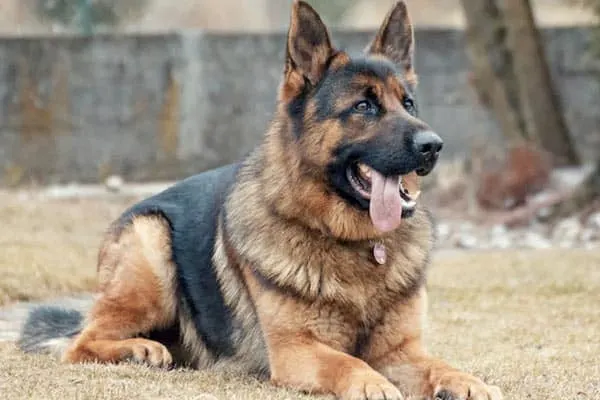
5 Major Types of German Shepherds
West German Working Lines
- Good guard, police, and military dogs
- Intense drive and excellent bite force
- Work long hours
- High prey drive
- More black than show lines
West German Show Lines
- Black and red
- Highly-angulated rear limbs
- Steady temperaments
East German Working Lines
- Most strictly-regulated of all dogs
- Darker than the other types
- Large heads and muscular bodies
Czech Working Lines
- Smaller yet powerfully built
- Can be black, tan, red, brown, or gray with a saddle pattern
- Square-like bodies with straight backs
American Show Lines
- Heavier and bulkier than working dogs
- The back drastically curves downward between the chest and lower back vertebrae
- Contrasting black-tan or red-tan
- Silver, blue, or black sables and blanket
Are there indeed different German Shepherd Breed types?
There are five recognized types of purebred German Shepherds.
The breed specifications separate each GSD type based on whether a dog is a show animal or working canine and what country is responsible for developing the individual’s family line.
We will go over the clear differences in appearance and less apparent variations in temperament.
In the end, we will briefly cover dogs that people call Shepherds but experts do not consider one of the officially-recognized GSD types and the contrasts between working and show dogs.
What Makes a German Shepherd?
All five types have characteristics in common that make them all German Shepherds.
When someone describes a German Shepherd, he or she is talking about a dog with one history, certain readily-identifiable physical traits, and unique temperament and mental make-up.
Over time, breeding for specific traits has enabled some variations in appearance and disposition unique to each of the types to emerge.
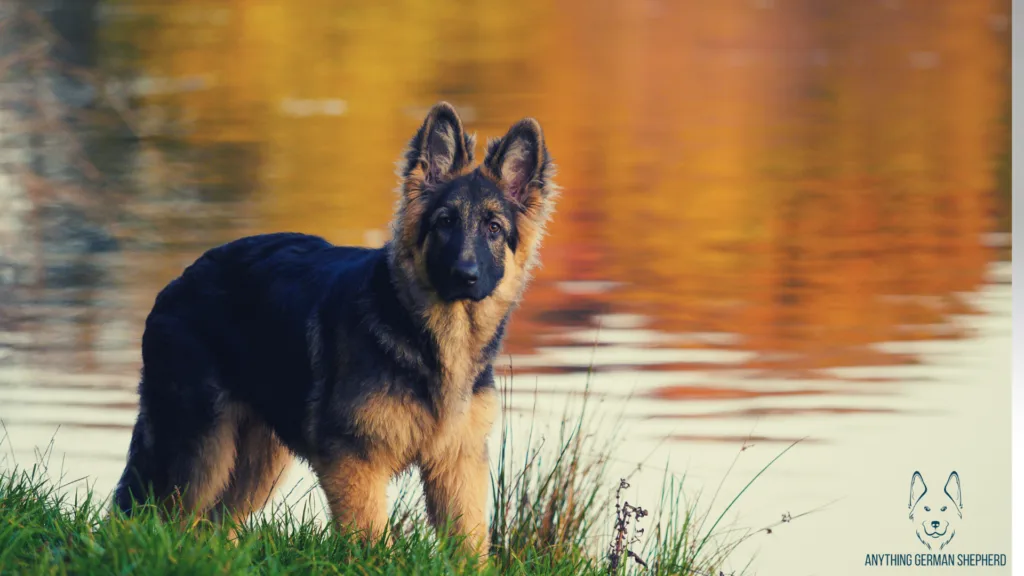
What is the background?
The German Shepherd sprang from a show dog named Hektor discovered by Max von Stephanitz in 1899.
Stephanitz used the dog as a sire to develop a versatile worker from herding dogs of Germany. All German Shepherd types have their backgrounds and initial family lines in Germany.
What is the appearance?
All Shepherd types will have the characteristic noble head with moderately large upright and pointed ears and a pronounced stop between muzzle and head to give a mild dome shape to their profile.
They have long but mildly square snouts with powerful jaws. Their eyes are medium, brown, and watchful. A German Shepherd’s gaze tends to be direct and unwavering, much as his character should be.
German Shepherd types are rectangular, significantly longer than they are tall. Shepherds have long bushy tails and short to long fur with a dense inner layer.
Most of them have two heavy periods of shedding annually. However, they shed moderately at all times. Regular brushing can help keep them clean and reduce shedding.
The Alsatian is medium-large and powerfully built without the bulk of bulldogs or Mastiffs.
German Shepherds are usually between 22 and 26 inches tall at the shoulders and weigh between 65 and 90 pounds. Size variations between the types are slight with quite a bit of overlap.
How can you assess disposition?
Any healthy German Shepherd you see will be energetic and very driven. All German Shepherds have a strong working heritage, regardless of modern uses.
They tend to be protective with an excellent guarding instinct and ability.
Show dogs, especially those destined for the companion dog sector, have seen the breeder’s attempt to select against aggression and drive.
A Shepherd’s demeanor with non-threatening strangers is approachable but not overly affectionate. Some dogs appear aloof.
German Shepherds are among the most intelligent dogs and extremely obedient. They require firm handling as they are physically and mentally strong.
Poorly-bred German Shepherds of any type may display fearfulness, unprovoked aggression, or neurosis.
Possible physical faults are hip and elbow dysplasia. Some registries take breeding quality dogs more seriously than others.
Learn More About The Major German Shepherd Types
West German Working Lines
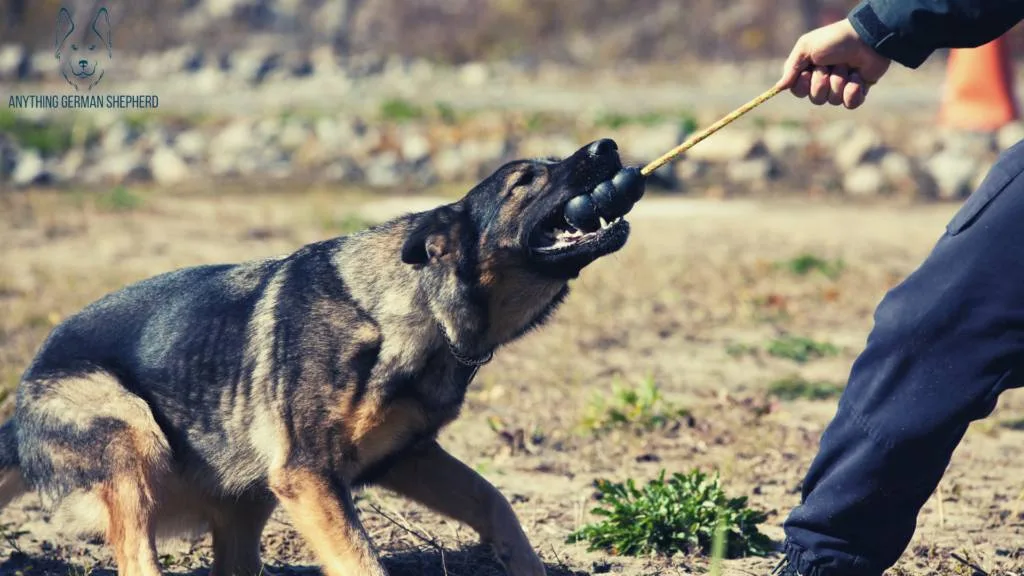
Breeders based the West German working line on Max von Stephanitz’s vision of the ideal working dog.
The working German Shepherd from these bloodlines most closely resembles the original dogs sired by foundation studs Hektor and Beowulf.
West German working lines have specific conformation and temperament qualifications considered essential to good guard, police, and military dogs.
They have the substance of bone that enables them to work long hours. West German working dogs also have an intense drive and excellent bite force.
The German GSD working line became the foundation of the West German show dog. Prey drive is high among the working dogs.
West German working Shepherds have more black than show lines but are not as dark as the DDR Shepherds.
They need a specific job to be happy and excel at obedience, search and rescue, drug sniffing, and obedience.
West German Show Lines
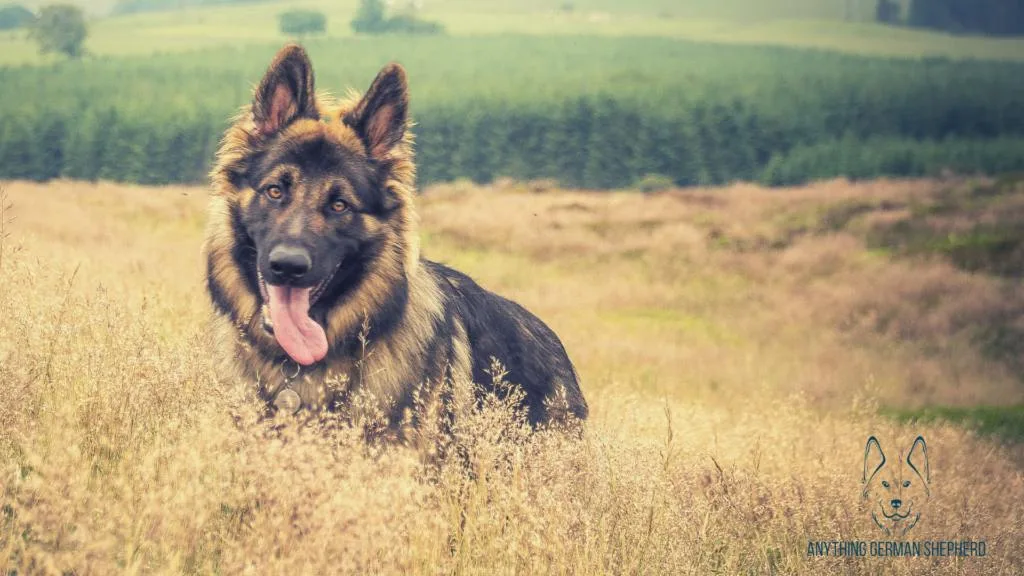
True to Stephanitz’s original breed standards, the Club for German Shepherds registry dictates West German Shepherd show dogs must have both working ability and beauty.
For owners to gain permission to breed their dogs, the respective Shepherds must have won conformation shows, Schutzhund competitions, and herding trials.
Proficiency at one of these jobs grants the Shepherd a Working Title.
Similar to the American show dogs, West German Show dogs often exhibit a steeper slope of the back than working dogs due to the extreme angles of the joints in the rear limbs.
Neither the incline of the topline nor the limb angulation is as dramatic as in the American show lines, discussed later.
West German show dogs are more often black and red where the American dogs are black and tan. The black is commonly in a saddle pattern across the back in contrast to working dogs.
According to Vongontahaus.com, the show line started to break away from the working line as late as the 1980s.
The dog who had a profound impact on the appearance of West German show dogs with highly-angulated rear limbs was Canto Von Der Wienerau.
West German show lines have a reputation for steady temperaments that do not have the edge present in working dogs.
Although they are more laidback than dogs who work in the field, they still require focused training and a lot of exercises.
East German Working Lines
The East German Working line, the so-called DDR German Shepherds, were able to develop unique features because of the isolation created by the Berlin wall.
Over the next 40 years, the Socialist Union Party of East Germany, more often called the East German Communist Party, oversaw German Shepherd breeding.
The GSD of East Germany became one of the most strictly-regulated of all dogs.
In East Germany, the government inspected DDR dogs and eliminated any with timid personalities, undescended testicles, hip dysplasia or other bone abnormalities, and imperfect dentition, among other flaws.
Inspectors were called breed wardens.
DDR Shepherds patrolled the Berlin Wall and the East German Czech borders. The Army used them as attack dogs and to track would-be deserters.
According to breeder Vom Banach K9, DDR dogs had to be able to scale six-foot barriers, and their fitness tests required them to search 10 blinds.
This video is just to provide context for a blind. In the case of adult dogs, the blinds are half a mile or more apart with people behind some of them.
Puppies need moderation of exercise and therefore do not receive such strenuous tests.
In 1989, with the dismantling of the Berlin Wall, the East German working line dispersed, the patrol dogs no longer needed.
The DDR line has been gradually declining since that time, with a few dedicated factions attempting to preserve it.
DDR German Shepherds, named after the Deutsche Demokratische Republik, are typically darker than the other types.
Both the police and military sought them out during and after World War II for their strong work ethic, athleticism, and fierce guard tendencies.
Their large heads and muscular bodies are signature features. Orthopedic abnormalities in purebred DDR dogs are rare.
Czech Working Lines
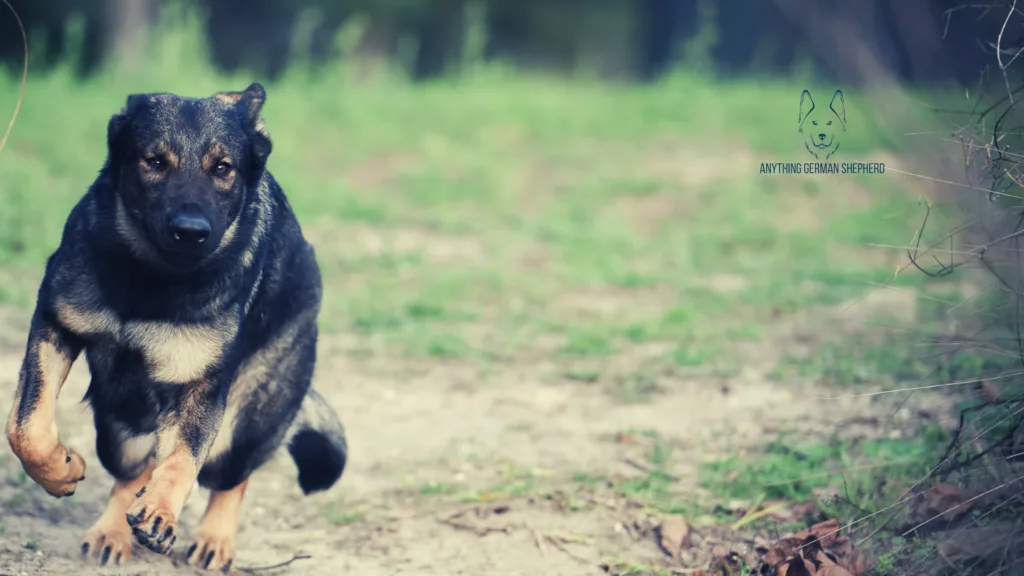
The Czech working Shepherd has the smallest stature and the most intensity of the German Shepherd types. Despite their smaller size, the Czech working dogs are powerfully-built.
Pohranicni Straze, Czechoslavakia’s Police border patrol, founded a kennel in 1955 for the specific purpose of breeding their working lines of German Shepherds.
They restricted all breeding to one kennel, utilizing dogs from both the East German working lines and historical Czech dogs.
Eventually, the Czech working line separated from the East German Shepherds, and the kennel expanded to other areas such as Lybejovice, Bratislava, Cheb, and Domazlice.
Jiri Novotny maintained strict breeding guidelines.
Czechoslovakia bred their German Shepherds mainly to patrol the border between Czechoslovakia and Germany.
Dogs had to be intimidating, and breeders accomplished this by producing darker and more uniformly solid colors.
Czech working lines also sought a masculine bearing, leading to less differentiation of the sexes.
There was even some experimentation with crossbreeding Shepherds with wolves.
While the project was short-lived and unsuccessful in producing viable working dogs, it did give rise to a new breed, the Czechoslovakian Wolfdog.
The Czech working lines can be black and tan, but where you might be more familiar with the saddle pattern, these Eastern European dogs will have full blankets.
More commonly, Czech working Shepherds are sable, either in shades of red, brown, or gray.
This is an example of a Czech working line dog. It is still a young dog, but you can observe the relatively small stature and solid composition.
The dog’s back is straight and body almost square compared to other types. Note the dog’s single-minded focus, intensity, drive, and aggression.
Czech working lines of German Shepherds have become quite popular, especially compared to the East German families.
Current breeders have aimed towards producing a calmer and friendlier pet-quality version than the original highly-driven and aggressive patrol dogs.
American Show Lines
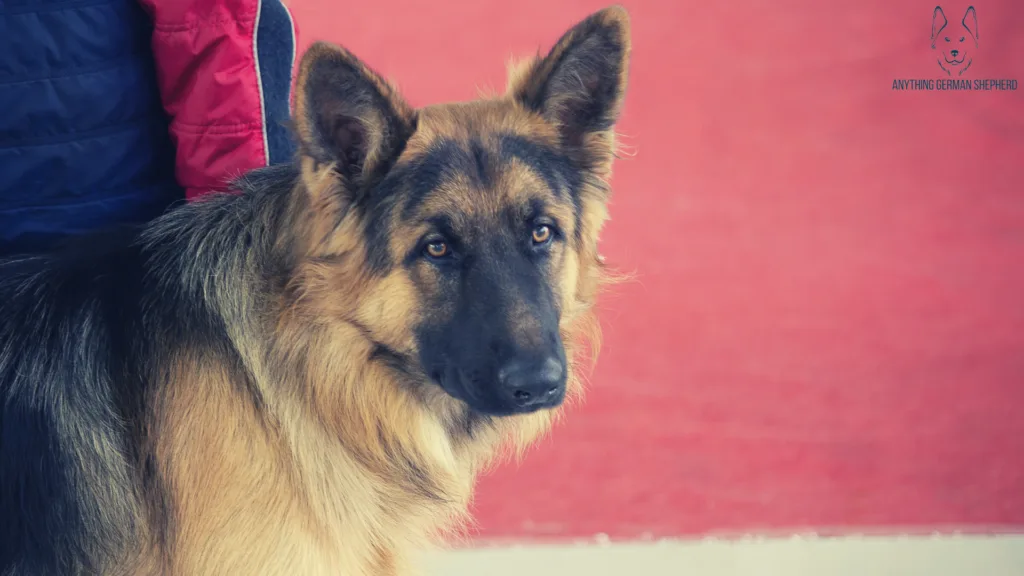
You may be curious about why there is not an American working line of German Shepherds.
Shepherds arrived in the United States in 1907, and a working dog was never the American intention in the breed’s development.
Where Stephanitz based his life’s work on his awe of the GSD as a working animal, the US was struck by the dog’s beauty and way of moving.
When American German Shepherds first entered the show rings in North America, they looked quite similar to their European counterparts.
However, their appearance started to change for several reasons. One obvious cause was the vast distance that separated them from European bloodlines.
Although some dogs retained their abilities as performance dogs, the vast majority evolved from a heavy emphasis on appearance and conformation.
Show line German Shepherds are generally larger than their working cousins. However, there are variations even among show dogs as breeders strive to keep up with what wins from year to year.
Guild of Shepherds and Collies says the GSD of the show ring is heavier and bulkier than working dogs.
While heavy-boned show dogs are present, we also saw examples of show Shepherds who were taller and lighter-boned than their working counterparts as reported by breeders such as Van der Otto.
One thing that is common to all show German Shepherds is the extreme angulation of the hind legs that results in a dramatic slope of the backs.
You can often see on these dogs a sharp transition where the back drastically curves downward between the thoracic (chest) and lumbar (lower back) vertebrae.
Show Shepherds, contrary to the working lines, generally exhibit vivid colors, with contrasting black and tan or red and tan. Sables and blanket blacks are rarer than eye-catching silvers or blues.
Many German Shepherd pet dogs come from American show lines unless someone actively seeks a dog with a European background. Companion dogs sold as pets often have conformational faults.
Others come from casual breeders, accidental litters, or puppy mills trying to make quick money. Therefore, they can vary widely in appearance, problem behaviors, and health issues.
White German Shepherds
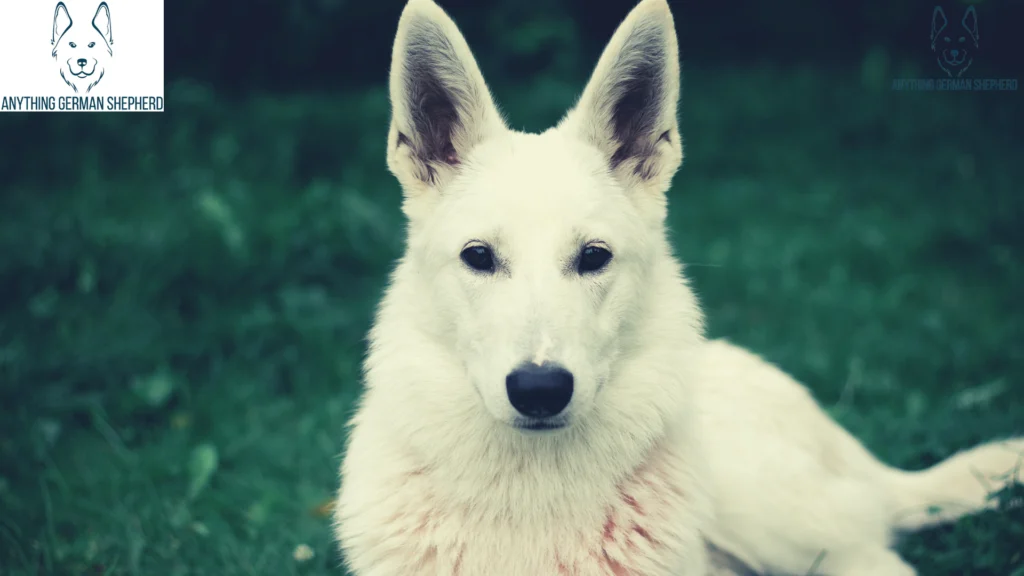
As a quick note, the AKC states white German Shepherds must be disqualified from sanctioned shows.
However, white Shepherd fanciers have their own breed shows and registries and do not condone the exaggerated joint angulation observed in the “true color” show lines.
Show White Shepherds have conformations more in keeping with their working backgrounds.
Almost German Shepherd types but not quite
Although comprised mostly of German Shepherd bloodlines, kennel clubs see these dogs as hybrids or purebred dogs to be classified separately.
It seems appropriate in the face of the fact that the development of the hybrids is ongoing.
Shiloh Shepherd
You could look at the Shiloh Shepherd as a designer dog. GSD lovers, concerned about where the breed was headed, sought to create a less aggressive, healthier, and more manageable family pet.
The Shiloh Shepherd originally saw contributions from German Shepherds selected for specific physical and temperamental traits.
Tina Barber sought to restore the greatness of German Shepherds she remembered from childhood and began her work in 1974.
The introduction of Alaskan Malamutes to the foundation dogs occurred in 1989 to ensure a larger size and to improve the hips.
Seeking to diversify its line of Shiloh Shepherds, the registry introduced a Canadian White Shepherd in 2001. This dog also added size.
Further diversity arrived with Czech Wolfdog bloodlines added around 2005.
Shiloh Shepherds are large, about 26 to 30 inches tall, and weighing 100 to 160 pounds. They can be black and tan or gold and tan, golden, red, or charcoal.
These dogs are affectionate, easy to train, loyal, protective, and reportedly good with children and other animals.
The Shiloh Shepherd is a herding breed and undergoes rigorous testing before allowed to breed. The American Breed Association has recognized Shilohs since 2004.
Shilohs are also proficient in search and rescue and therapy work.
Interestingly, the breed standard calls for dogs to exhibit the flying trot in the show ring, whereby the forelegs must extend beyond the plane of the nose when moving.
However, any imbalance or fault in the carriage is severely penalized. Only time will tell if this standard wreaks havoc on the dog’s conformation.
King Shepherds
King Shepherd is a German Shepherd hybrid developed by people who wanted to create a giant-sized GSD. David Turkheimer and Shelly Watts-Cross succeeded in the 1990s with King Shepherds.
Early dogs involved crosses between the Shiloh Shepherd and the German Shepherd with infusions from the Great Pyrenees, large Spitz types like the Alaskan Malamute, and European families of German Shepherds.
Some sources also credited the Akita with a bit of influence on the King Shepherd breed.
King Shepherds are giant dogs, topping out at 29 to 30 inches tall and weighing up to 150 pounds. Even females are around 27 inches tall and weigh over 100 pounds.
King Shepherds should be gentler than the GSD but share other qualities such as courage, loyalty, and good guard instincts. They can be sable, black, and tan, cream, or fawn.
Czechoslovakian Wolfdog
If the Czechoslovakian Wolfdog had fared better as a patrol dog, as mentioned earlier, it may have become a German Shepherd type.
Instead, people who first conceived of the idea to crossbreed working German Shepherds with Carpathian wolves focused on creating a new breed.
The Wolfdog first-generation crosses were not amenable to training.
It took three and four generations for the majority of wolf-GSD hybrids to make good border patrols, and at this stage, they showed phenomenal stamina as well as better night vision and navigational capacities than their purebred counterparts.
However, by this time the patrol dog’s use was coming to an end.
Czechoslovakian Wolfdogs are recognized as a breed in several countries and as a wolf hybrid in others.
As affectionate, loyal, and protective family dogs, Wolfdogs are gaining popularity outside of their homeland in countries like the UK and Italy.
Although they bond closely with their entire family, they are not for everyone as they can be difficult to train and control. Some areas ban wolf hybrids of any kind.
Czechoslovakian Wolfdogs are only about 6.25% wolf and the remainder GSD, but they look like their lupine ancestors and must learn to bark.
You can mistake Belgian Shepherds for German Shepherd types
There are four recognized Belgian Shepherds. Mainly the Belgian Malinois and Belgian Tervuren can be mistaken for German Shepherd types because of their striking resemblance to GSD coloration.
There is also the black Belgian Sheepdog or Groenendael and the woolly-coated Laekenois.
All the Belgian Shepherds once roamed similar areas as what would develop into Alsatians, Briards, and Dutch Shepherds.
The Dutch, Belgian, and German Shepherds officially split in the 1890s. The Belgian Shepherd began development as a unique breed in 1892.
Depending on the locale, registries recognize Belgian Shepherds as variations of one breed or four distinct dog breeds.
Belgian Malinois
Quite similar to the German Shepherd in appearance and personality, the Belgian Malinois became a common sight in the US military and on the police force beginning in 1984, according to The Los Angeles Times.
They even made a run at replacing many German Shepherds in the late 1980s in the United States and Germany, thought to be more driven and healthier with higher stamina and longer lifespans.
Many military operations are following suit with the US and phasing out Germans Shepherds in favor of Belgian Malinois, often criticizing Alsatians for being too smart and not brave enough, especially for terrorist operatives.
The Belgian Malinois can be differentiated from the Shepherd by his proportionately longer legs, more angular head, and shorter coat. Most are varying shades of fawn.
They are the same height as Shepherds with a squarer body and lighter build.
Belgian Tervuren
Similar in size and color to the Belgian Malinois, the Belgian Tervuren has a medium-long wavy double coat, often with a black blanket over a fawn base.
Dutch Shepherd
The Dutch Shepherd is also not a German Shepherd type. The Dutch and German Shepherd split ways in 1898, as stated by The Spruce Pets when breeders came up with a standard for the Dutch Shepherd.
In 1914, fanciers changed the standard to exclude all but brindle dogs.
Other than their brindle coloring, Dutch Shepherds resemble working German Shepherds in both appearance and disposition.
They are loyal and affectionate to their families with a noble head and natural guard instincts. Their occurrence, however, is rare.
Controversy surrounds the GSD Show line vs working types
We would be remiss not to discuss the great divergence of the show and working lines of German Shepherds.
Detrimental characteristics began to enter Shepherds of the Western world as breeders became fixated on appearance at the expense of the German Shepherd’s athleticism and utilitarianism.
Most everyone is familiar with the American Saddlebred horses with their exaggerated knee action that catches the eye as they stride out and prance.
Breeders discovered that highly angulated limbs and a steep pelvis would create a similarly flashy movement of the front legs in their Shepherds.
The “high flying” gait became desirable, and little attention was paid to the weakness that developed in the hindquarters or the detrimental effect such a slope in the back might cause.
Jean Mueller Wrote a telling article, published by Leeburg Dog Training, where she discussed how the highly-angled pelvis and resulting steep croup are valuable for dogs that move at great speeds like the Greyhound or Whippet with their double-suspension gallop.
However, she mentioned a steep pelvis is inappropriate for a working dog who is meant to travel mostly at a trot with short bursts of speed, turning on a dime, and accomplishing balanced lateral movements.
Mueller and others have received vehement criticism from the GSD show dog community who insist their dogs can still perform in the field.
The stance maintains the more angulation a dog the better her ability to propel herself.
This video by k9-1.com compares the various German Shepherd types working.
The American show dog type does seem to perform proficiently, but he also does not exhibit the degree of joint angulation observed in the ring.
Despite what anyone says to the contrary, police officers on public forums state they will rarely if ever consider show lines for their working dogs.
They state show dogs are typically not aggressive, brave, or driven enough to be suitable for enforcement work. This sentiment is echoed by trainers and breeders of working dogs like Leeburg.
Moreover, show dogs do not have the strength, endurance, or coordination required of a hardcore working dog.
On the other hand, many qualities that make show dogs unsuitable military dogs may make them better pets than the working lines.
They are bred to possess less aggression and lower exercise requirements. However, more than a few of them are fearful or suffer emotional disorders.
The controversial instability you see in the hindquarters of some show line dogs is because the animal has lost the ability to maintain alternate limb movement required for the walk or trot because the legs are over angulated.
Lack of balance also makes these dogs difficult to control as they seek to stabilize their centers of gravity.
Worse than balance issues is setting up show dogs for life-shortening illnesses such as arthritis and IVDD as well as problems they historically did not worry about, like obesity.
Sources like Gizmodo.com express concern that rising health problems may be contributing to the decline in the German Shepherd’s popularity.
The American Kennel Club recommends screening the hips and elbows of breeding German Shepherds.
Although anyone can register any purebred dog with the AKC, potential owners can check whether the parents of a pup they are considering purchasing has undergone recommended certifications.
German show and working lines still maintain screenings of breeding individuals for stable temperament, lack of hip and elbow dysplasia, and the ability to perform either Shutzhund, with protective evaluation, or herding.















